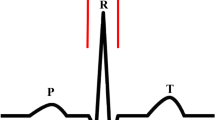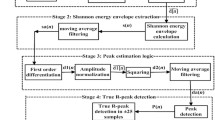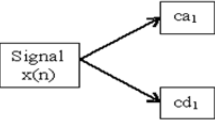Abstract
The QRS complex is considered to be one of the main factors in diagnosing heart diseases; thus, its detection on the electrocardiogram signals has become the target of various types of research. The primary aim of this study is to design and develop a novel technique for QRS complex detection under various ECG signal morphologies and different QRS waveforms. In this study, we report an algorithm for detecting the QRS complex using the Shannon energy (SE) and Teager energy operator (TEO) to obtain valid QRS on ECG signals. In this scheme, the first stage includes SE and band-pass filter for QRS complex localization. Next, the novel process of R-peak detection based on TEO to create a smoothed detection mask is considered. Finally, the proposed method’s performance and validity are tested on the Massachusetts Institute of Technology–Beth Israel Hospital arrhythmia database. To this end, a highly accurate, quick, and simple mathematical operation is provided based on SE and TEO, with baseline threshold and minimum lag. The efficiency of the undertaken method for detecting the QRS complex compared to recent state-of-the-art methods shows an accuracy of 99.829%. Also, the proposed approach is designed with three quick and straightforward stages by low computational time complexity for setting up and applying reliable cardiac QRS detection.




Similar content being viewed by others
Data Availability
The data used to support the findings of this study are available in [28].
References
A. Amirou, D. Ould-Abdeslam, Z. Zidelmal, M. Aidene, J. Merckle, Using S-transform and Shannon energy for electrical disturbances detection, in IECON 2014—40th Annual Conference of the IEEE Industrial Electronics Society, 29 Oct.–1 Nov. 2014 (2014), pp. 2452–2457
M.M. Benosman, F. Bereksi-Reguig, E.G. Salerud, Strong real-time QRS complex detection. J. Mech. Med. Biol. 17(08), 1750111 (2017). https://doi.org/10.1142/s0219519417501111
H. Beyramienanlou, N. Lotfivand, Shannon’s energy based algorithm in ECG signal processing. Comput. Math. Methods Med. 2017, 8081361 (2017). https://doi.org/10.1155/2017/8081361
H. Beyramienanlou, N. Lotfivand, An efficient Teager energy operator-based automated QRS complex detection. J. Healthc. Eng. 2018, 8360475 (2018). https://doi.org/10.1155/2018/8360475
B. Biswal, ECG signal analysis using modified S-transform. Healthc. Technol. Lett. 4(2), 68–72 (2017). https://doi.org/10.1049/htl.2016.0078
C.J. Deepu, Y. Lian, A joint QRS detection and data compression scheme for wearable sensors. IEEE Trans. Biomed. Eng. 62(1), 165–175 (2015). https://doi.org/10.1109/TBME.2014.2342879
L. El Bouny, M. Khalil, A. Adib, A wavelet denoising and Teager energy operator-based method for automatic QRS complex detection in ECG signal. Circuits Syst. Signal Process. (2020). https://doi.org/10.1007/s00034-020-01397-8
A. Felinger, Data analysis and signal processing in chromatography (Elsevier, Amsterdam, 1998)
A.L. Goldberger, L.A. Amaral, L. Glass, J.M. Hausdorff, P.C. Ivanov, R.G. Mark, J.E. Mietus, G.B. Moody, C.K. Peng, H.E. Stanley, PhysioBank, PhysioToolkit, and PhysioNet: components of a new research resource for complex physiologic signals. Circulation 101(23), E215–E220 (2000). https://doi.org/10.1161/01.cir.101.23.e215
S. Hamdi, A.B. Abdallah, M.H. Bedoui, A robust QRS complex detection using regular grammar and deterministic automata. Biomed. Signal Process. Control 40, 263–274 (2018). https://doi.org/10.1016/j.bspc.2017.09.032
R.S. Holambe, M.S. Deshpande, Nonlinear measurement and modeling using Teager energy operator, in Advances in Non-Linear Modeling for Speech Processing. Springer Briefs in Electrical and Computer Engineering (Springer, Berlin, Germany, 2012), pp. 45–59. https://doi.org/10.1007/978-1-4614-1505-3_4
C. Kamath, A new approach to detect congestive heart failure using sequential spectrum of electrocardiogram signals. Med. Eng. Phys. 34(10), 1503–1509 (2012). https://doi.org/10.1016/j.medengphy.2012.03.001
A. Kaur, S. Kumar, A. Agarwal, R. Agarwal, An efficient R-peak detection using Riesz fractional-order digital differentiator. Circuits Syst. Signal Process. 39(4), 1965–1987 (2020). https://doi.org/10.1007/s00034-019-01238-3
X. Lu, M. Pan, Y. Yu, QRS detection based on improved adaptive threshold. J. Healthc. Eng. 2018, 5694595 (2018). https://doi.org/10.1155/2018/5694595
G. Luo, Z. Yang, The application of ECG cancellation in diaphragmatic electromyographic by using stationary wavelet transform. Biomed. Eng. Lett. 8(3), 259–266 (2018). https://doi.org/10.1007/s13534-018-0064-5
M.S. Manikandan, K.P. Soman, A novel method for detecting R-peaks in electrocardiogram (ECG) signal. Biomed. Signal Process. Control 7(2), 118–128 (2012). https://doi.org/10.1016/j.bspc.2011.03.004
J.P. Martinez, R. Almeida, S. Olmos, A.P. Rocha, P. Laguna, A wavelet-based ECG delineator: evaluation on standard databases. IEEE Trans. Biomed. Eng. 51(4), 570–581 (2004). https://doi.org/10.1109/TBME.2003.821031
J. Mateo, A.M. Torres, M.A. García, J.L. Santos, Noise removal in electroencephalogram signals using an artificial neural network based on the simultaneous perturbation method. Neural Comput. Appl. 27(7), 1941–1957 (2016). https://doi.org/10.1007/s00521-015-1988-7
G.B. Moody, MIT-BIH Arrhythmia Database Directory (1997). https://www.physionet.org/physiobank/database/html/mitdbdir/records.htm . Accessed 22 July 2020
C. Nayak, S.K. Saha, R. Kar, D. Mandal, Optimal SSA-based wideband digital differentiator design for cardiac QRS complex detection application. Int. J. Numer. Model. Electron. Netw. Dev. Fields 32(2), e2524 (2019). https://doi.org/10.1002/jnm.2524
C. Nayak, S.K. Saha, R. Kar, D. Mandal, An efficient QRS complex detection using optimally designed digital differentiator. Circuits Syst. Signal Process. 38(2), 716–749 (2019). https://doi.org/10.1007/s00034-018-0880-y
N. Ortigosa, C. Fernández, A. Galbis, Ó. Cano, Classification of persistent and long-standing persistent atrial fibrillation by means of surface electrocardiograms. Biomed. Eng. 61(1), 19 (2016). https://doi.org/10.1515/bmt-2014-0154
J. Pan, W.J. Tompkins, A real-time QRS detection algorithm. IEEE Trans. Biomed. Eng. BME-32(3), 230–236 (1985). https://doi.org/10.1109/tbme.1985.325532
D. Pandit, L. Zhang, C. Liu, S. Chattopadhyay, N. Aslam, C.P. Lim, A lightweight QRS detector for single lead ECG signals using a max-min difference algorithm. Comput. Methods Programs Biomed. 144, 61–75 (2017). https://doi.org/10.1016/j.cmpb.2017.02.028
D. Panigrahy, P.K. Sahu, Extended Kalman smoother with differential evolution technique for denoising of ECG signal. Australas. Phys. Eng. Sci. Med. 39(3), 783–795 (2016). https://doi.org/10.1007/s13246-016-0468-4
J.-S. Park, S.-W. Lee, U. Park, R peak detection method using wavelet transform and modified Shannon energy envelope. J. Healthc. Eng. 2017, 4901017 (2017). https://doi.org/10.1155/2017/4901017
Z. Peng, G. Wang, H. Jiang, S. Meng, Research and improvement of ECG compression algorithm based on EZW. Comput. Methods Programs Biomed. 145, 157–166 (2017). https://doi.org/10.1016/j.cmpb.2017.04.015
physionet.org: MIT-BIH Arrhythmia Database (2005). https://physionet.org/content/mitdb/1.0.0/. Accessed 22 July 2020
Q. Qin, J. Li, Y. Yue, C. Liu, An adaptive and time-efficient ECG R-peak detection algorithm. J. Healthc. Eng. 2017, 5980541 (2017). https://doi.org/10.1155/2017/5980541
M. Rakshit, D. Panigrahy, P.K. Sahu, An improved method for R-peak detection by using Shannon energy envelope, Sādhanā. Acad. Proc. Eng. Sci. 41(5), 469–477 (2016). https://doi.org/10.1007/s12046-016-0485-8
S. Rekik, N. Ellouze, Enhanced and optimal algorithm for QRS detection. IRBM 38(1), 56–61 (2017). https://doi.org/10.1016/j.irbm.2016.11.004
B.T. Ricardo Ferro, A. Ramírez Aguilera, R.R.F. de la Vara Prieto, Automated detection of the onset and systolic peak in the pulse wave using Hilbert transform. Biomed. Signal Process. Control 20, 78–84 (2015). https://doi.org/10.1016/j.bspc.2015.04.009
P. Sabherwal, M. Agrawal, L. Singh, Automatic detection of the R peaks in single-lead ECG signal. Circuits Syst. Signal Process. 36(11), 4637–4652 (2017). https://doi.org/10.1007/s00034-017-0537-2
T. Sharma, K.K. Sharma, QRS complex detection in ECG signals using locally adaptive weighted total variation denoising. Comput. Biol. Med. 87, 187–199 (2017). https://doi.org/10.1016/j.compbiomed.2017.05.027
T. Sharma, K.K. Sharma, A new method for QRS detection in ECG signals using QRS-preserving filtering techniques. Biomed. Eng. 63(2), 207 (2018). https://doi.org/10.1515/bmt-2016-0072
L.D. Sharma, R.K. Sunkaria, A robust QRS detection using novel pre-processing techniques and kurtosis based enhanced efficiency. Measurement 87, 194–204 (2016). https://doi.org/10.1016/j.measurement.2016.03.015
A. Sharma, S. Patidar, A. Upadhyay, U. Rajendra Acharya, Accurate tunable-Q wavelet transform based method for QRS complex detection. Comput. Electr. Eng. 75, 101–111 (2019). https://doi.org/10.1016/j.compeleceng.2019.01.025
R.L. Verrier, B.D. Nearing, Ambulatory ECG monitoring of T-wave alternans for arrhythmia risk assessment. J. Electrocardiol. 36(Suppl), 193–197 (2003). https://doi.org/10.1016/j.jelectrocard.2003.09.058
Ö. Yakut, E.D. Bolat, An improved QRS complex detection method having low computational load. Biomed. Signal Process. Control 42, 230–241 (2018). https://doi.org/10.1016/j.bspc.2018.02.004
Q. Zhang, D. Zhou, X. Zeng, HeartID: a multiresolution convolutional neural network for ECG-based biometric human identification in smart health applications. IEEE Access 5, 11805–11816 (2017). https://doi.org/10.1109/ACCESS.2017.2707460
Acknowledgements
The author wants to extend his deepest gratitude to acknowledge the valuable comments of Editor-in-Chief and reviewers. The author would also like to thank dear Tanya Sehrgosha for her contribution to the manuscript’s language revision.
Funding
The author received no specific funding for this work.
Author information
Authors and Affiliations
Corresponding author
Ethics declarations
Conflicts of interest
The author declares that he has no conflict of interest.
Human and Animals Participants
This article does not contain any studies with human participants or animals performed by any of the authors.
Additional information
Publisher's Note
Springer Nature remains neutral with regard to jurisdictional claims in published maps and institutional affiliations.
Rights and permissions
About this article
Cite this article
Beyramienanlou, H. A Robust Method to Reliable Cardiac QRS Complex Detection Based on Shannon Energy and Teager Energy Operator. Circuits Syst Signal Process 40, 980–992 (2021). https://doi.org/10.1007/s00034-020-01510-x
Received:
Revised:
Accepted:
Published:
Issue Date:
DOI: https://doi.org/10.1007/s00034-020-01510-x




